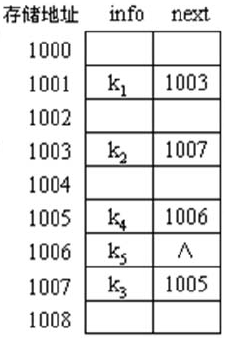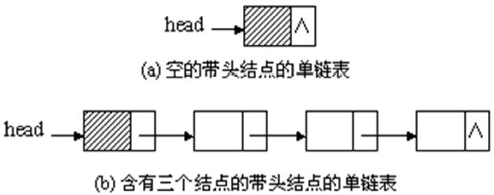一、 链式存储
以结点的形式存储数据。除了存放一个结点的信息外,还需附设指针。

数据在内存中存储是不连续的,每个结点只能也只有它能知道下一个结点的存储位置。
二、单链表
单链表是线性表链式存储的一种,其储存不连续。单链表的数据结构中包含两个变量:数据和指向下一结点的指针。一个结点只知道下一个结点的地址。一个单链表必须有一个头指针,指向单链表中的第一个结点。否则链表会在内存中丢失。
三、单链表的操作和实现
1、单链表定义
2、创建一个空链表
3、打印链表
4、查找数据值为x的结点
5、查找索引值为index的结点
6、在i位置插入一个结点
7、在数据y之后插入一个x结点
8、删除i位置的结点
9、删除值为x的结点
1、单链表定义
01.typedef int datatype; 02. 03.typedef struct link_node{ 04. datatype info; 05. struct link_node* next; 06.}node;
2、创建一个空链表
01.#include"linklist.h" 02. 03.node* init_linklist(){ 04. return NULL; 05.}3、打印链表
01.#include"linklist.h" 02. 03.void display_link_list(node *head){ 04. if(head == NULL){ 05. printf("the list is empty!\n"); 06. }else{ 07. node *ptr = head; 08. while(ptr){ 09. printf("5%d",ptr->info); 10. ptr = ptr->next; 11. } 12. } 13.}4、查找数据值为x的结点
01.#include"linklist.h" 02. 03.node *find_node(node* head,datatype x){ 04. node* ptr= head; 05. while(ptr && ptr->info != x) 06. ptr= ptr->next; 07. return ptr; 08.}5、查找索引值为index的结点
01.#include"linklist.h" 02. 03.node* find_index(node* head,int index){ 04. node *ptr = head; 05. int pos = 0; 06. if(index<0){ 07. printf("Index Error\n"); 08. exit(1); 09. } 10. while(ptr && pos != index){ 11. ptr=ptr->next; 12. pos++; 13. } 14. return ptr; 15.}6、在i位置插入一个结点
01.#include"linklist.h" 02. 03.node* insert_link_list_index(node *head,int index,datatype x){ 04. if(index<0){ 05. printf("index error\n"); 06. exit(1); 07. } 08. if(index == 0){ //在头插入元素,不用判断链表是否为空 09. node *q = (node*) malloc(sizeof(node)); 10. q->info = x; 11. q->next = head; 12. head = q; 13. return head; 14. } 15. else{ 16. node *ptr = find_node(head,index-1); 17. node* q = (node*)malloc(sizeof(node)); 18. q->info = x; 19. q->next = ptr->next; 20. ptr->next = q; 21. return head; 22. } 23.}7、在数据y之后插入一个x结点
01.#include"linklist.h" 02. 03.node* intsert_node_yx(node *head,datatype x,datatype y){ 04. node *q=find_node(head,y); 05. if(!q){ 06. printf("not found the node %d\n"); 07. return head; 08. } 09. node *p = (node*)malloc(sizeof(node)); 10. p->info = x; 11. p->next= q->next; 12. q->next = p; 13. return head; 14.}
8、删除i位置的结点
01.#include"linklist.h" 02. 03.node* del_link_list_index(node* head,int index){ 04. if(!head){ 05. printf("the list is empty\n"); 06. return head; 07. } 08. node* p=head,*q=NULL; 09. if(index == 0){ //第一个元素 10. head = head->next; 11. }else{ 12. p=find_index(head,index-1); //上面定义的第5个函数 13. if(p && p->next){ 14. q = p->next; 15. p->next= q->next; 16. }else{ 17. printf("the index is not exit\n"); 18. return head; 19. } 20. } 21. free(q); 22. return head; 23.}9、删除值为x的结点
01.#include"linklist.h" 02. 03.node* del_link_list_node(node* head,datatype x){ 04. if(!head){ 05. printf("the list is empty\n"); 06. return head; 07. } 08. node* ptr=head,*pre=NULL; 09. while(!ptr && ptr->info != x){ 10. pre = ptr; 11. ptr=ptr->next; 12. } 13. if(!ptr){ //没找到 14. printf("no data\n"); 15. }else if(pre){ //第一个就是 16. head=ptr->next; 17. }else{ //链表中的某个位置 18. pre->next= ptr->next; 19. } 20. free(ptr); 21. return head; 22.}三、带头结点的单链表
头结点的单链表中,head指示的是所谓的头结点,它不是实际的结点,不是用来储存数据的。可以这样理解,头结点牺牲了一个储存单元,来化简代码,因为头不可能为空了。或者用来存储一些全局量,比如链表长度,这要依具体需求而定。
四、带头结点的单链表操作实现
因为结构有变化,所以实现有变化但是变化并不多。
1、创建一个空链表
2、打印链表
3、删除值为x的结点
1、创建一个空链表
01.#include"linklist.h" 02. 03.node* init_hlink_list(){ 04. node *head; 05. head=(node*)malloc(sizeof(node)); 06. head->next=NULL; 07. return head; 08.}2、打印链表
01.#include"linklist.h" 02. 03.void display_link_list(node *head){ 04. if(head->next == NULL){ 05. printf("the list is empty!\n"); 06. }else{ 07. node *ptr = head->next; 08. while(ptr){ 09. printf("5%d",ptr->info); 10. ptr = ptr->next; 11. } 12. } 13.}
3、删除值为x的结点
01.#include"linklist.h" 02. 03.node* del_link_list_node(node* head,datatype x){ 04. if(!head->next){ 05. printf("the list is empty\n"); 06. return head; 07. } 08. node* ptr=head->next,*pre=head; 09. while(!ptr && ptr->info != x){ 10. pre = ptr; 11. ptr=ptr->next; 12. } 13. if(ptr){ 14. printf("no data\n"); 15. }else { //两种情况合并到一起了 16. pre->next= ptr->next; 17. } 18. free(ptr); 19. return head; 20.}
五、循环单链表
链表中最后一个结点的指针指向第一个结点。在这个链表中,若首指针为head,最后一个结点的判断条件为:p->next == head。
六、循环单链表的操作和实现
1、打印链表
2、获得最后一个结点
3、找到值为x的结点
4、在i位置插入一个结点
5、在数据y之后插入一个x结点
6、删除值为x的结点
1、打印链表
01.#include"linklist.h" 02. 03.void display_link_list(node *head){ 04. if(head == NULL){ 05. printf("the list is empty!\n"); 06. }else{ 07. node *ptr = head->next; 08. printf("%5d",head->info); 09. while(ptr != head){ //如果采用ptr->next != head 的方法无法判断最后一个元素! 10. printf("5%d",ptr->info); 11. ptr = ptr->next; 12. } 13. } 14.}2、获得最后一个结点
01.#include"linklist.h" 02. 03.node* get_rear(node *head){ 04. node* ptr = head; 05. while(ptr &&ptr->next != head) { 06. ptr= ptr->next; 07. } 08. return head; 09.}3、找到值为x的结点
01.#include"linklist.h" 02. 03.node *find_node_clink(node* head,datatype x){ 04. node*ptr = head->next; 05. if(head->info != x){ //如果第一个元素就是就直接走else返回 06. while(ptr != head && ptr->info != x){ 07. ptr= ptr->next; 08. } 09. if(ptr == head){ //处理没有找到的情况 10. ptr = NULL; 11. } 12. return ptr; 13. }else{ 14. return head; 15. } 16.}
4、在i位置插入一个结点
01.#include"linklist.h" 02. 03.node* insert_link_list_index(node *head,int index,datatype x){ 04. if(index<0){ 05. printf("index error\n"); 06. exit(1); 07. } 08. if(index == 0){ //在链表头插入 09. node *p = (node*) malloc(sizeof(node)); 10. node *rear; 11. p->info = x; 12. if(!head){ //空链表的处理 13. head = p; 14. p->next = head; 15. return head; 16. }else{ //正常在链表头插入的处理 17. rear = get_rear(head); 18. rear->next = p; 19. p->next = head; 20. head = p 21. return head; 22. } 23. } 24. else{ //在链表中插入的处理 25. node *ptr= find_node(head,index-1); 26. node* q = (node*)malloc(sizeof(node)); 27. q->info = x; 28. q->next = ptr->next; 29. ptr->next = q; 30. return head; 31. } 32.}5、在数据y之后插入一个x结点
01.#include"linklist.h" 02. 03.node* intsert_node_yx(node *head,datatype x,datatype y){ 04. node *q=find_node_clink(head,y); //此处调用的是第3个函数 05. if(!q){ 06. printf("not found the node %d\n"); 07. return head; 08. } 09. node *p = (node*)malloc(sizeof(node)); 10. p->info = x; 11. p->next= q->next; 12. q->next = p; 13. return head; 14.}6、删除值为x的结点
01.#include"linklist.h" 02. 03.node* del_link_list_node(node* head,datatype x){ 04. if(!head){ 05. printf("the list is empty\n"); 06. return head; 07. } 08. node* ptr=head,*pre=NULL; 09. while(ptr->next != head && ptr->info != x){ 10. pre = ptr; 11. ptr=ptr->next; 12. } 13. if(ptr->info != x){ //判断最后一个元素的同时也判断了是否找到元素 14. printf("no data\n"); 15. }else if(!pre){ //第一个元素就是x 16. pre = get_rear(head); //不要忘了尾指针指头 17. head=ptr->next; 18. pre->next =ptr; 19. }else{ //在链表中的情况 20. pre->next= ptr->next; 21. } 22. free(ptr); 23. return head; 24.}转载:点击打开链接


